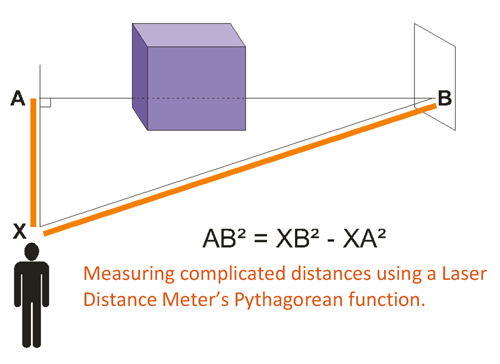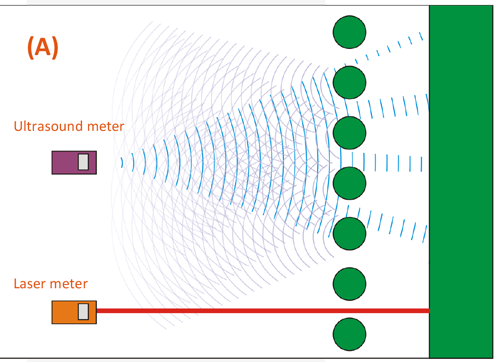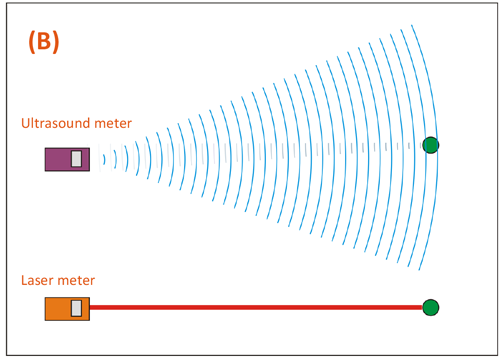SUMMARY
A Laser Distance Meter sends a pulse of laser light to the target and measures the time it takes for the reflection to return. For distances up to 30m, the accuracy is É3mm. On-board processing allows the device to add, subtract, calculate areas and volumes and to triangulate. You can measure distances at a distance.
Compared with a good, old-fashioned tape there’s no contest. A Laser Distance Meter wins on every count: speed , accuracy, safety, versatility, convenience and functionality.
Ultrasonic devices offer many of the same features but are less accurate.
Basic Principles
A Laser Distance Meter* sends out a finely focussed pulse of light to the target and detects the reflection. The meter measures the time between those two events, and converts this to a distance. The formula is simple: Distance = 1/2 (Speed x Time). However the speed of light is 300,000 km per second, so to resolve differences of (say) 1 cm, the meter must measure time intervals of the order of billionths of a second. But don’t worry – the technology is well established and reliable! A laser distance meter can measure distances of up to 30m with an accuracy of +/-3mm.
An Ultrasonic Distance Meter works on a similar principle, but instead of light it uses sound with a pitch too high for the human ear to hear. The speed of sound is only about ⅓ of a km per second, so the time measurement is easier, but there are other issues, as we shall see below.
* Note that we are not looking at laser ‘range finders’ – these are much less accurate, and are typically used in golf, hunting and forestry.
Why not use a Tape?
A Laser Distance Meter is accurate to within a few millimetres, certainly equalling a tape for larger distances, and the line is always dead straight – no bending or sagging! You have a choice of units, and there is no risk of misreading, as with the intermediate marks on a tape.
The Laser Distance Meter is much faster – point, click, and you have the result in front of you on the display. The job is done in just a fraction of the time it would take to use a tape.
You don’t need to walk to and fro, or have a helper at the other end. What is more, you can use it with one hand, leaving the other free to hold your notebook.
With a backlit display and the laser dot itself, you can use your Laser Distance Meter in relatively poor lighting conditions. There’s no need to wait until morning or to rig up lights.
You don’t have to access the far end of the measurement range or poke anything where it shouldn’t be poked. Only the laser light has to do that – you do not have to worry about obstacles on the ground, or even large features such as pipes or cables. If there is a line of sight to your target, and it is within range, you can very quickly find out exactly how far away it is.
For the same reason, you can measure upwards without climbing – to a ceiling or to the top of a building. So, the Laser Distance Meter brings safety benefits as well. No more scrambling up ladders or over steep or wet surfaces to get a measurement. T
hese safety and versatility benefits are particularly valuable in hazardous environments, and there will be occasions when you would not be able to do the job at all with a tape. Only a Laser Distance Meter will do.






